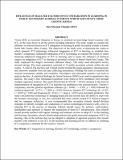| dc.description.abstract | Vision 2030, an economic blueprint in Kenya, is anchored on knowledge based economy with ICT, as the main driver in all the sectors including education. The study sought to examine the influence of selected factors on ICT integration in learning in public secondary schools in Imenti North Sub County, Meru County. The objectives of the study were: to determine the extent to which dynamic ICT technology influenced integration of ICT in learning, to establish how teacher’s competency influenced integration of ICT in learning, to examine the extent to which financing influenced integration of ICT in learning, and to assess the influence of technical support on integration of ICT in learning in secondary schools in Imenti North Sub County. The study employed the Rogers innovation diffusion theory. The study used descriptive survey research design. The study population consisted of 13 public secondary schools within the sub county. A total of 354 teachers and 13 head teacher formed the target population. Questionnaires and interview schedule were the data collecting instruments. Piloting was done to establish the research instruments validity and reliability. Descriptive and inferential statistics was used to analyze the data. A statistical Package for Social Sciences (SPSS) was used in quantitative data analysis. The study’s four formulated hypotheses were tested at 95% confidence level through multiple regression analysis. The result showed that 61.5% (R2 = 0.615) variation in the level of implementation of integration of ICT in learning was attributed to the selected factors. Teacher’s competency had the greatest significant influence (β = 0.660, t = 4.505, p < 0.05) followed by technical support (β = 0.271, t = 2.868, p < 0.05). However, dynamic ICT technology (β = 0.107, t = 0.819, p > 0.05) and financing (β = 0.142, t = 1.444, p > 0.05) were not potent predictors. The study concluded that technology is changing drastically and schools lack the ability to cope with the dynamic technology. It was also concluded that most schools lacked ICT technical support had no computer technician. It was recommended that secondary schools should develop strategies to identify strengths and weaknesses of various technological resources with a view to adopting ICT in the process of learning. Schools should source for partners, well-wishers, stakeholders and sponsors to finance the acquisition of more ICT infrastructure. Also schools should provide teachers with regular trainings and seminars on how to adopt ICT in the teaching and learning. Secondary schools should adopt policies that guide structured integration of ICT on learning. One of the policies that can be adopted is adoption of appraisal practices that reward teachers who endeavor to use ICT in the teaching and learning process in addition to outlining ICT competency standards for the teachers’ trainers. | en_US |

